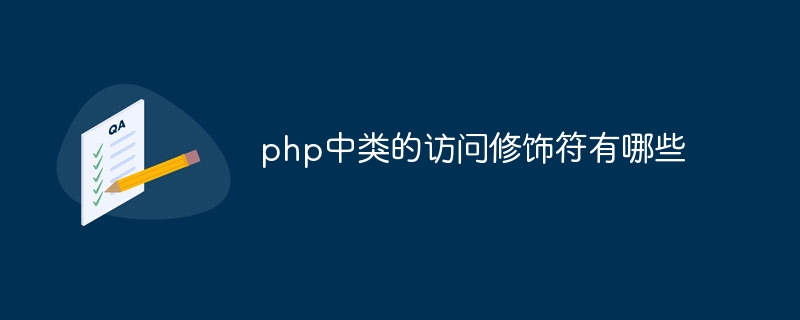
The access modifiers of classes in php include public modifier, protected modifier and private modifier. Detailed introduction: 1. The public modifier is the most common access modifier of a class. It indicates that the properties and methods are visible and accessible to the inside, subclasses and outside of the class. Properties and methods modified with the public modifier can be Accessed and called anywhere; 2. The protected modifier indicates that the properties and methods are visible and accessible to the interior and subclasses of the class, but invisible to the outside, etc.

The operating system of this tutorial: Windows10 system, PHP version 8.1.3, DELL G3 computer.
In PHP, the access modifier of a class is used to control the visibility and access permissions of the properties and methods of the class. There are three common class access modifiers in PHP, namely public, protected and private. Below I will introduce the characteristics and usage of each modifier in detail:
1. Public modifier: The public modifier is the most common access modifier of a class. It indicates that attributes and methods are accessible to the internal and sub-classes of the class. Both class and external are visible and accessible. In other words, properties and methods modified with the public modifier can be accessed and called from anywhere.
For example:
class MyClass { public $publicProperty; public function publicMethod() { // 公共方法的实现 } } $obj = new MyClass(); $obj->publicProperty = 'Hello'; echo $obj->publicProperty; // 输出:Hello $obj->publicMethod(); // 调用公共方法
2. protected modifier: The protected modifier indicates that the properties and methods are visible and accessible to the interior and subclasses of the class, but are invisible to the outside. In other words, properties and methods modified with the protected modifier can only be accessed and called within the class and in subclasses.
For example:
class MyClass { protected $protectedProperty; protected function protectedMethod() { // 受保护方法的实现 } } class SubClass extends MyClass { public function accessProtected() { $this->protectedProperty = 'Hello'; echo $this->protectedProperty; // 输出:Hello $this->protectedMethod(); // 调用受保护方法 } } $obj = new SubClass(); $obj->accessProtected();
In the above example, SubClass is a subclass of MyClass. It can access and call the properties and methods modified by the protected modifier in MyClass.
3. Private modifier: The private modifier indicates that the properties and methods are only visible and accessible within the class, and are invisible to subclasses and the outside. In other words, properties and methods modified with the private modifier can only be accessed and called within the class.
For example:
class MyClass { private $privateProperty; private function privateMethod() { // 私有方法的实现 } public function accessPrivate() { $this->privateProperty = 'Hello'; echo $this->privateProperty; // 输出:Hello $this->privateMethod(); // 调用私有方法 } } $obj = new MyClass(); $obj->accessPrivate();
In the above example, the accessPrivate method is a public method in the MyClass class. It can access and call properties and methods modified with the private modifier.
It should be noted that the access modifier of a class can only be applied to the properties and methods of the class, not to the entire class itself. In addition, if the properties and methods of a class are not modified with any access modifier, they are public by default.
By rationally using the access modifier of a class, you can control the visibility and access rights of the properties and methods of the class, and improve the encapsulation and security of the code. According to specific business needs and design principles, choose appropriate access modifiers to define members of the class to facilitate code maintenance and expansion.
The above is the detailed content of What are the access modifiers for classes in php. For more information, please follow other related articles on the PHP Chinese website!